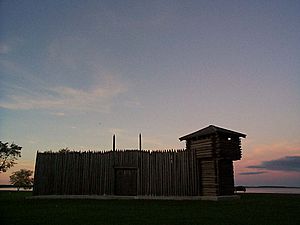Fort Saint Pierre facts for kids
Quick facts for kids Fort Saint Pierre National Historic Site |
|
|---|---|
| Fort Saint Pierre | |
 |
|
| Built | 1731 |
| Original use | Trading post |
| Website | Fort St. Pierre National Historic Site |
| Lua error in Module:Location_map at line 420: attempt to index field 'wikibase' (a nil value). | |
| Designated: | 28 May 1934 |
Fort Saint Pierre was an important French fort. It was built on Rainy Lake in 1731. This fort was the first French fort built west of Lake Superior. It was also the first of many forts. These forts helped with trade and exploration. They were built by a famous explorer named La Vérendrye.
Contents
Exploring the Fur Trade Route
Fort Saint Pierre played a key role in the fur trade. It was located on a major route. This route connected the Great Lakes to the lands further west.
Early Visits to the Area
Long ago, in 1688, a European explorer named Jacques de Noyon visited this area. He might have built a small camp here. This spot was important for the fur trade. You can learn more about this route on the Winnipeg River page.
Building Fort Saint Pierre
In 1731, La Vérendrye reached Grand Portage. Many of his men did not want to go further west. It was late in the year, and the land was unknown. La Vérendrye and most of his men stayed at Fort Kaministiquia for the winter.
However, he sent a small group of men west. This group was led by Christopher Dufrost de La Jemeraye. They reached Rainy Lake before it froze. They built Fort Saint Pierre at the lake's outlet. The next spring, they sent furs back east. La Vérendrye arrived in July. He then continued west to Lake of the Woods. There, he built Fort Saint Charles. Fort Saint Charles soon became more important than Fort Saint Pierre.
Life at the Fort
French traders, called coureurs des bois, spread out from the fort. They traded with local Indigenous peoples. This helped draw trade away from the English. The area around the fort had fish and wild rice. The local people were the Monsonis. The Cree lived further west. Both groups were at war with the Sioux to the south.
The fort was used until 1758. Later, between 1775 and 1787, the North West Company built Fort Lac la Pluie nearby.
Location and Reconstruction
Fort Saint Pierre was on the north bank of the Rainy River. It was near some rapids. This spot is now the modern town of Fort Frances.
There was a modern copy of the fort built. But it was taken down in 2003. The building was in very bad condition.
Important Allies
A Monsoni chief named La Colle helped La Vérendrye a lot. His main camp was near the fort. He and his warriors helped control the Sioux of the Prairies. This was during the time La Vérendrye was exploring and building forts to the west.
Commemorative Plaque Details
A plaque from Historic Sites and Monuments of Canada tells us more:
"The first post on Rainy Lake was Fort Tekamanigan built by Robutel de La Noue in 1717, but soon abandoned, probably because of Sioux hostility. In 1734 the Sieur La Jemeraye, La Verendrye's nephew and lieutenant, constructed Fort St. Pierre at the south-west end of the lake where it drains into the Rainy River. As one of the postes de la Mer de l'Ouest it served as a trading post and a base for La Verendrye's westward explorations. Fort St. Pierre was abandoned by the French about 1758 during the course of the Seven Years War."
This means that Fort Tekamanigan was built first in 1717. But it was soon left empty. This was probably because of conflicts with the Sioux. Fort St. Pierre was built later, in 1734, by La Jemeraye. It was a trading post. It was also a base for La Vérendrye's trips to the west. The French left Fort St. Pierre around 1758. This was during the Seven Years' War.

